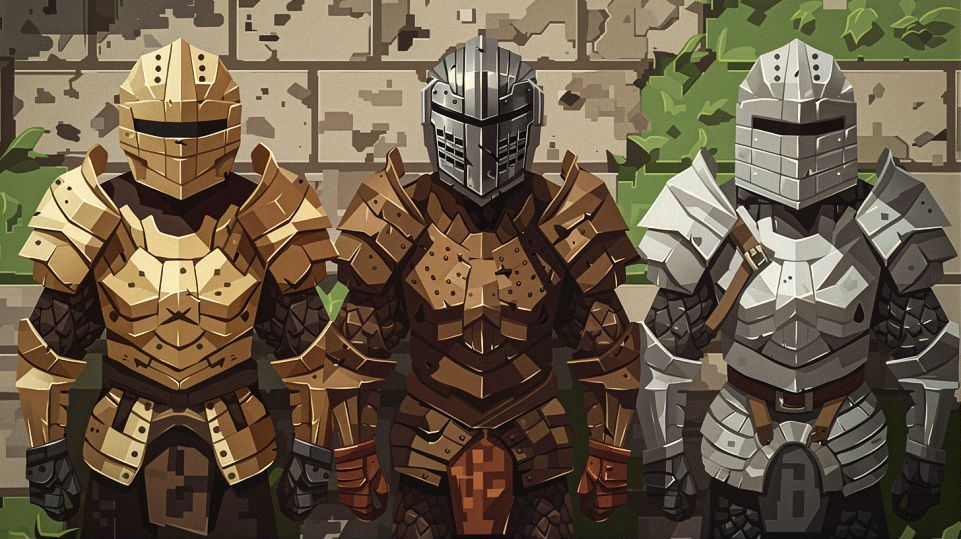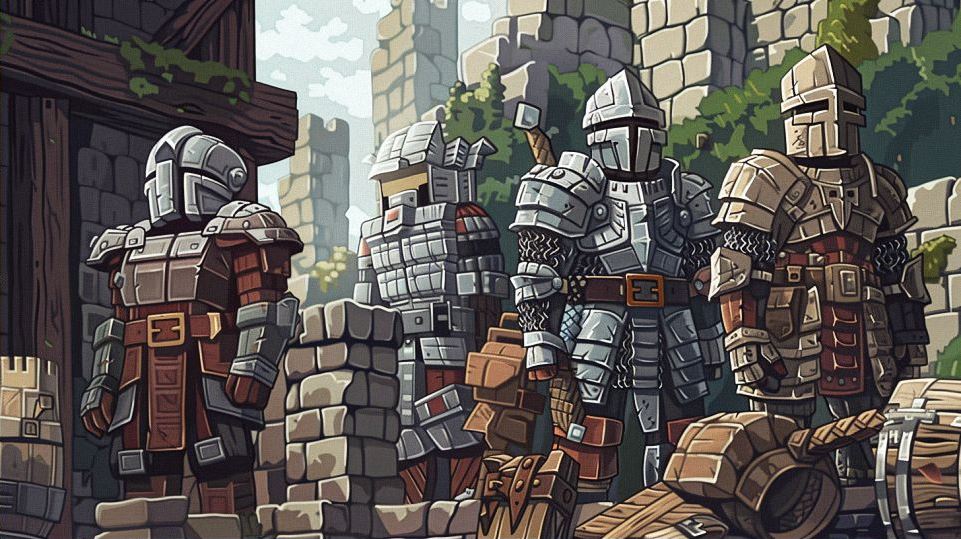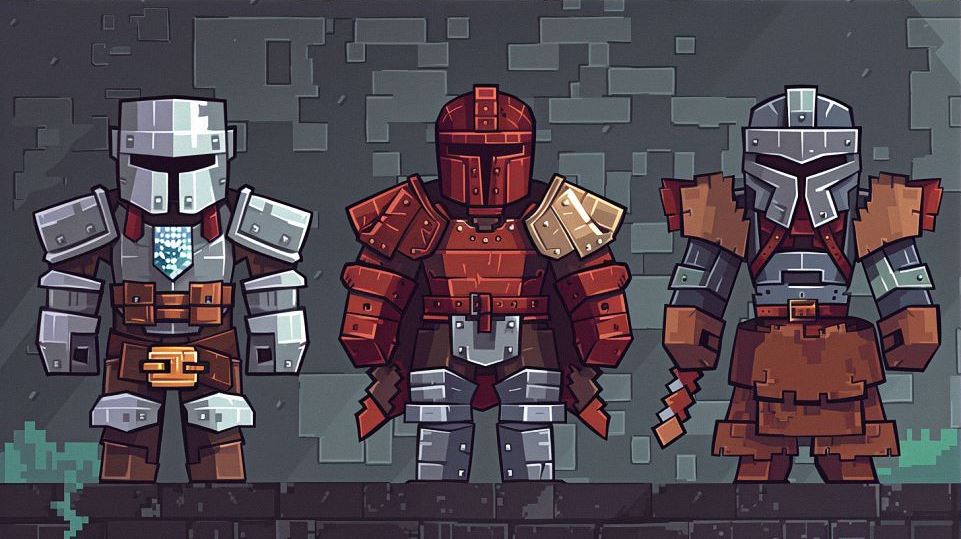Best Armor in Minecraft: Your Ultimate Guide

Understanding Armor Types in Minecraft
Leather Armor: Basic Protection and Dyes
Leather armor is the first line of defense for many new players in Minecraft. It’s crafted from leather, which you can obtain from cows or horses. While it offers the least protection among all armor types, it’s better than nothing when you’re just starting out. One of the unique features of leather armor is its ability to be dyed. Using a crafting table and dyes, you can change the color of each piece, allowing you to customize your look. Whether you want to match your favorite color or create a unique style, leather armor’s dyeable property makes it special.
Contents
ToggleChainmail Armor: Rare and Unique Properties
Chainmail armor stands out due to its rarity and unique method of acquisition. You can’t craft chainmail armor, instead, you must find it in chests within structures like dungeons or temples, or you might get lucky and trade with villagers or defeat mobs wearing it. Chainmail provides better protection than leather but is less durable than iron. Its distinct chain-link design is visually appealing and offers moderate defense, making it a coveted piece for players seeking a balance between aesthetics and functionality.
Iron Armor: Balance of Accessibility and Strength
Iron armor is the go-to choice for many players due to its accessibility and strength. Crafted from iron ingots, which are abundant in the game, iron armor provides substantial protection without requiring rare materials. It strikes a balance between durability and defensive capability, making it ideal for both exploring and combat. As you venture deeper into caves and face tougher enemies, iron armor will be your reliable ally, offering a solid defense against most threats you encounter in the game.
Gold Armor: Enchantability and Aesthetic Appeal
Gold armor, while often overlooked due to its low durability, offers the highest enchantability among all armor types. This means that when you enchant gold armor, you have a better chance of getting powerful enchantments. Additionally, gold armor has a striking appearance with its shiny, bright yellow color, making it a favorite for players who want to stand out. Despite its fragility, the ability to easily enchant gold armor with high-level enchantments makes it useful for specific situations, especially in environments where enchantments play a crucial role.
Diamond Armor: High Durability and Protection
Diamond armor is synonymous with high protection and durability. Crafted from diamonds, one of the rarest resources in the game, diamond armor offers exceptional defense, making it essential for surviving the toughest challenges. Its high durability means it will last longer under stress, reducing the frequency of repairs or replacements. Players often strive to acquire diamond armor before taking on formidable foes like the Ender Dragon or the Wither, as its robust defense can make the difference between victory and defeat.
Netherite Armor: Ultimate Defense and Knockback Resistance
Netherite armor represents the pinnacle of protection in Minecraft. To obtain it, you must upgrade your diamond armor using Netherite ingots, which are derived from ancient debris found in the Nether. This process requires dedication and time, but the rewards are worth it. Netherite armor not only offers superior durability and protection compared to diamond armor, but it also provides knockback resistance, reducing the impact of hits from enemies. This feature is invaluable in combat, helping you maintain your position and control over battles. As the best armor in Minecraft, Netherite armor ensures you’re well-equipped to face any challenge the game throws your way.

Crafting and Upgrading Your Armor
Essential Materials for Crafting Each Armor Type
Crafting armor in Minecraft requires specific materials, each varying in rarity and availability. Here’s a quick rundown of what you need for each type:
- Leather Armor: You’ll need leather, which you can get from cows or horses. To craft a full set, you’ll need 24 pieces of leather.
- Chainmail Armor: This type can’t be crafted traditionally but can be found in chests, traded from villagers, or dropped by mobs.
- Iron Armor: For iron armor, you need iron ingots. Collect 24 iron ingots to craft a complete set.
- Gold Armor: Gold ingots are required for gold armor. Like iron, you’ll need 24 gold ingots for a full set.
- Diamond Armor: Diamonds are the key ingredient here. A full diamond armor set requires 24 diamonds.
- Netherite Armor: Upgrade diamond armor with Netherite ingots, which are crafted from ancient debris found in the Nether.
Step-by-Step Guide to Crafting Armor Pieces
Crafting armor pieces is straightforward once you have the materials. Follow these steps to create your protective gear:
- Helmet: Place five of your chosen material in a helmet shape in the crafting table – three in the top row and two in the second row’s sides.
- Chestplate: Fill the first and third columns of the crafting grid, leaving the middle row’s center empty.
- Leggings: Use seven pieces in an inverted U shape, filling all except the bottom center.
- Boots: Place two materials in the bottom left and right corners and two more above them.
Repeat these steps for each material type to complete your armor sets.
Upgrading to Netherite Armor: Required Tools and Process
Netherite armor represents the pinnacle of protection in Minecraft. Upgrading from diamond armor to Netherite requires a few key steps and tools:
- Collect Ancient Debris: Found in the lower levels of the Nether, typically between Y-levels 8 and 22. Mine at least four pieces.
- Smelt Ancient Debris: Use a furnace or blast furnace to smelt the ancient debris into Netherite scraps.
- Craft Netherite Ingots: Combine four Netherite scraps with four gold ingots in a crafting table to create one Netherite ingot.
- Use a Smithing Table: Place your diamond armor piece and a Netherite ingot in the smithing table to upgrade it to Netherite armor.
Enchanting Your Armor: Key Enchantments and Their Effects
Enchanting your armor can significantly enhance its abilities, offering a range of benefits:
- Protection: Reduces overall damage from attacks.
- Fire Protection: Decreases damage from fire and lava.
- Blast Protection: Reduces damage from explosions.
- Projectile Protection: Lessens damage from projectiles like arrows.
- Unbreaking: Increases the armor’s durability, making it last longer.
- Mending: Uses experience points to repair the armor.
- Thorns: Damages attackers when they hit you.
To enchant your armor, use an enchantment table and lapis lazuli, or combine enchanted books with your armor on an anvil.
Repairing Armor: Anvils, Experience, and Strategies
Keeping your armor in top condition is essential for survival. Here’s how to repair your gear:
- Anvils: Combine damaged armor with the same material or another damaged piece on an anvil. This costs experience points (XP).
- Crafting Table: Combine two damaged pieces of the same type in a crafting table to create a less damaged piece.
- Mending Enchantment: If your armor has the Mending enchantment, collect experience orbs to automatically repair it.
Balancing resource use and XP management is crucial. Sometimes, it’s more efficient to craft new pieces, while other times, repairing and enchanting existing armor offers better long-term benefits.
By understanding and mastering these crafting and upgrading processes, you’ll ensure your armor provides maximum protection, keeping you safe during your Minecraft adventures.

Best Practices for Using Armor in Gameplay
Armor for Exploration: Balancing Protection and Speed
When embarking on exploration quests in Minecraft, finding the right balance between protection and speed is key to a successful journey. Here’s how to optimize your armor for exploration:
- Leather or Chainmail: Opt for lighter armor like leather or chainmail to maintain agility while still providing basic protection against environmental hazards and minor threats.
- Enchantments: Prioritize enchantments like Feather Falling to reduce fall damage and Depth Strider to increase underwater movement speed, enhancing your mobility during exploration.
- Elytra Wings: Pair your armor with Elytra wings for unparalleled aerial exploration, allowing you to soar through the skies and cover vast distances quickly.
Armor in Combat: PvP and PvE Strategies
In combat scenarios, whether facing off against other players (PvP) or hostile mobs (PvE), your choice of armor and strategic approach can determine the outcome. Consider the following strategies:
- Diamond or Netherite: Equip yourself with durable armor such as diamond or Netherite for maximum protection in intense battles, ensuring you can withstand enemy attacks.
- Enchantments: Prioritize defensive enchantments like Protection and Projectile Protection to minimize damage from both melee and ranged attacks.
- Tactical Positioning: Utilize terrain and cover to your advantage, maneuvering strategically to avoid taking unnecessary hits while maintaining offensive pressure on your opponents.
Armor in the Nether and End: Special Considerations
Navigating the challenging landscapes of the Nether and End realms requires special considerations when it comes to armor selection:
- Fire Protection: Equip armor with Fire Protection enchantments to mitigate damage from the Nether’s hostile environment, including lava and fire-based attacks from mobs.
- Endermen: In the End, where Endermen roam freely, prioritize armor with high durability and defensive enchantments like Thorns to deter their attacks effectively.
- Ender Dragon: When facing the formidable Ender Dragon, focus on combining durability, projectile protection, and mobility-enhancing enchantments to survive its onslaught and emerge victorious.
Maintaining Your Armor: Tips for Longevity and Efficiency
To ensure your armor remains in peak condition throughout your adventures, follow these maintenance tips:
- Repair Regularly: Use anvils or crafting tables to repair damaged armor pieces using matching materials, preserving their durability for extended use.
- Enchantment Preservation: Prioritize using the Mending enchantment to automatically repair your armor using experience orbs, reducing the need for manual repairs and resource expenditure.
- Strategic Storage: Store spare armor sets in chests to prevent excessive wear and tear during exploration or combat, rotating them as needed to maintain optimal performance.
Mixing and Matching Armor Pieces for Optimal Benefits
Harness the full potential of your armor by mixing and matching pieces to capitalize on their unique attributes:
- Hybrid Sets: Combine different armor types to create hybrid sets that offer a balance of protection, mobility, and enchantability, tailored to your specific playstyle and objectives.
- Specialized Combinations: Experiment with combining specific pieces, such as wearing a Turtle Shell Helmet for water breathing alongside other armor pieces optimized for combat or exploration.
- Enchantment Synergy: Strategically apply complementary enchantments across your armor set to maximize their collective effectiveness, creating synergistic combinations that enhance your overall survivability and capabilities.
By implementing these best practices, you’ll elevate your gameplay experience in Minecraft, mastering the art of armor usage and optimizing your performance across all aspects of your adventures.


